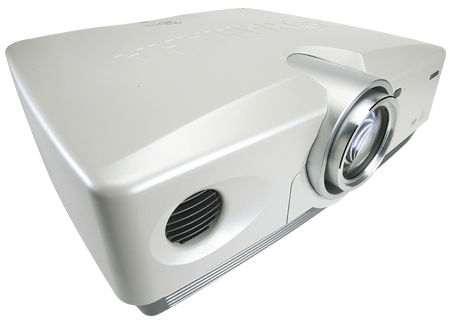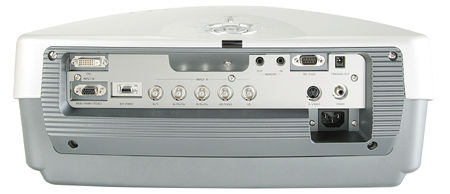Yamaha DPX-1000 DLP Projector

Both points have merit. CRT projectors still provide the best gray-scale reproduction and shadow detail of any front-projection technology I've tested, but they have limitations in brightness and screen size—not to mention that CRT is an expensive, high-maintenance technology.
The advantage of a front-projection system that uses microdisplays instead of tubes is that it works much as a 35mm film projector does. In a film projector, light from the projection lamp is modulated by images fixed on the film, providing a range of color and gray-scale information. As a result, it's possible to project film images onto some really big screens—all that's needed is enough horsepower from the lamp. The same holds true for such microdisplay technologies as LCD, LCoS, and DLP. The imager and the light source are forever separate, and the resolution of one is unaffected by the brightness of the other. Also, such a system is inherently less complex and costly to operate and maintain in the home.
The Yamaha DPX-1000 is another in a line of high-end, single-chip DLP projectors based on Texas Instruments' latest HD2 digital micromirror device (DMD), an imaging chip with 1280x720 pixels that achieves better contrast and darker levels of gray than its predecessor. It presents a mixed bag of operating features and performance that succeeds well in some ways, not so well in others.
Out of the Box
Like most other DLP front projectors in its class, the Yamaha DPX-1000 is a solid, heavy design intended for a permanent installation. The case, finished in attractive matte silver, has a center-mounted lens, and all heat from the projector exhausts out the side. Recirculating air is drawn in through a front grille, and the fan is very quiet. (Yamaha claims 30dB fan noise in Standard mode.)
All connectors are found on the DPX-1000's rear, and there's a full complement of them. You can choose from composite (RCA), S-video (DIN), and a pair of analog component inputs. Either of these two connectors (15-pin D-sub, five BNC) can be used for RGB or Y-Pb-Pr hookups from set-top boxes, DVD players, video scalers, and video signal switchers. You can also connect the projector to a PC.
The I/O complement is finished off by a DVI-D port (for so-equipped set-top boxes and DVD players) and a D4 connector, an analog component interface currently used only in Japan. There's also a 12V screen trigger, RS-232C jack for a system control (such as from Crestron), and a hardwired I/O connection for the included remote (which can also operate as an IR remote).

The supplied remote is stylish and easy to operate, with good IR range. Only six of its buttons are backlit, however: Power, Auto sync mode, Menu, Input, Aspect Ratio, and Escape. There are six more buttons for direct access to any video input, and another six for selecting picture-memory presets. You can also access all controls through buttons on the top of the projector.
The DPX-1000 offers powered, mechanical lens offset for parallax control, as well as digital keystone correction. Use the latter only as a last resort—it remaps the image across the available DMD pixels, and some weird artifacts can result. Shifting the lens mechanically is the smarter way to go if you mount the DPX-1000 above or below the screen's centerline. I was able to shift the image +/-25 inches vertically when projecting onto an 80-inch-wide Da-Lite front screen, and saw no vignetting of the image (soft edges or pixels outside the area covered by the lens).
Menus and Operation
Overall, I was quite happy with the DPX-1000's menu design and operation. You can engage many functions as you set up the projector; you can also rely on the factory presets and be none the worse off.
The menu appears either as a monochrome overlay graphic or in color—your choice. You can move the menu around the screen as needed to make adjustments, which is a big help when adjusting PLUGE for contrast and brightness, or calibrating color bars. All settings are done with left/right slider indicators. To save your settings in a given memory, select that memory and make the desired changes.
In addition to the usual basic picture adjustments, the DPX-1000 lets you choose among 10 gamma settings. These settings have no obvious correlation to defined gamma settings such as 2.2 or 2.5—you just select the curve you think gives you the most pleasing image and desired gray-scale response. (Most of the time I used "2" and "3," which I believe correspond to gamma settings of 2.2 and 2.5.)
There are also four image-enhancement tools, such as a variable sharpness (peaking) slider, and five image-sharpness presets. As a rule, I stay away from such controls when watching any component-video content, particularly coming from HDTV sources and progressive-scan DVD players. Happily, none of this signal-processing is present until you decide to engage it, unlike the Marantz VP-12S2 DLP front-projector I reviewed earlier this year (see the May 2003 issue).























































